30305261 JTY-GD-G3点型光电感烟火灾探测器说明书
- 格式:doc
- 大小:929.00 KB
- 文档页数:5
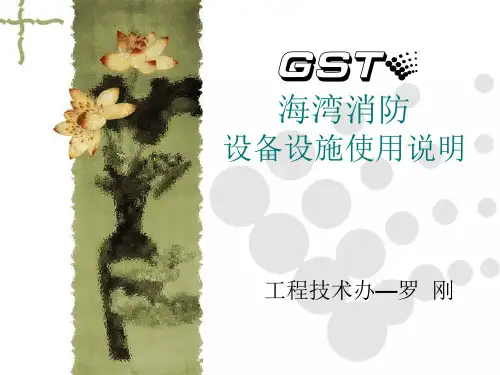
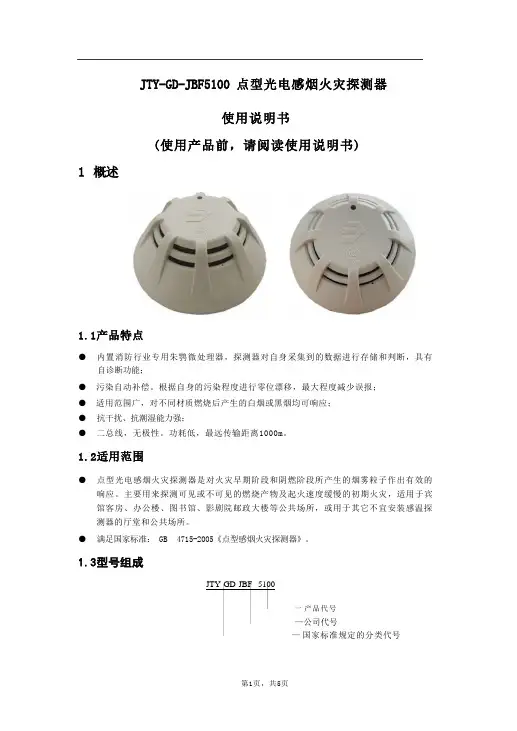
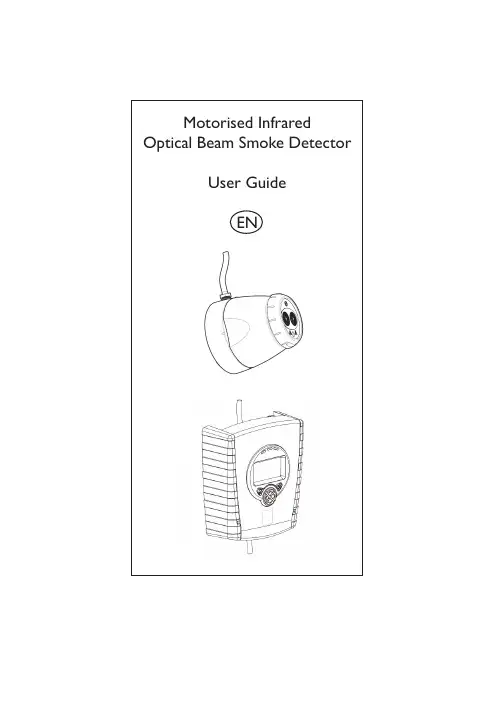
•All installations should comply with local regulations•For detectors approved to UL268refer to NFPA72for installation guidance.In such installations,it is advised that the maximum distance of Detector and Reflector from the ceiling must be 10%of the distance between floor and ceiling•For installations covering less than 18m,the Short Range Mask must be used•Position beam as high as possible,but with a minimum distance of 0.5m from Detector and Reflector to ceiling.•Mount Detector and Reflector directly opposite each other•Do NOT position Detector where personnel or objects can enter the beam path •Do NOT position 2Detectors facing each other •Detector LED indicator must face downward•Do NOT install the Detector or Reflector in environments where condensation or icing are likely tooccur18—50m =150—100m =48—18m =1Use Short RangeMaskEnsure clear line ofsight from Detector to ReflectorMount on solid surfaces (structural wall or girder)1.General Information2.Fitting the ProductClip PCB intobaseInsert DetectorcableLED indicator must face downward3.Wiring DiagramsWiring two Detectors onto two Zones:To Detector 1To Detector 2EOL EOLDET 1DET 2N/OCOMN/CN/OCOMN/CN/OCOMN/CN/OCOMN/C14V -36V DC123123123Con C Zone 1-Zone 1+Zone 2+Zone 2-Supply +Ext Reset Supply -Con A Con B see note 1see note 1ExtReset123Con D •Note 1:This component is the fire resistor.Its value is specified by the Fire Control Panel manufacturer.For U.S.installations it is typically a short circuit •ALWAYS use a separate 2-core cable for each Detector head•CAUTION:For system monitoring -Do not use looped wire under any terminals.Break wire run to provide monitoring of connections •Components not supplied:•End Of Line ('EOL')component -supplied by Fire Control Panel manufacturer •Fire Resistor•After installation,check operation of Fire and Fault connection on Fire Panel•Apply a voltage of 5V to 40V to ‘Ext Reset’contact for at least 2seconds to clear a latched fire conditionFireFaultFire Fault3.Wiring Diagrams (continued)Relay connections for wiring the two Detectors of one Controller onto one Zone:For wiring to other types of Fire Control Panel,or to wire multiple Controllers onto one Zone,refer to additional installation instructions supplied with the productEOLN/O COM N/C N/O COM N/CN/OCOMN/CN/OCOMN/C123123123Con C Zone 1-Zone 1+Con A Con B see note 1123Con D Fire Fault FireFault5seconds5secondsNOTE:One System Controller can be used to control and monitor up to two Detector heads.The ‘#’symbol in this guide is used to represent the number of the Detector currently selected (1or 2).4.Apply power•Commissioned system:•Detectors have been found but the selected Detector is not aligned:•Detector is connected butnot ‘Found’(normal on uncommissionedsystem):•Communications fault,or no Detector connected:Pressfor Pass Codescreen:•Default PassCode:1234•Change digit •Move between digits •Accept•An incorrect Pass Code will return the display to the Pass Code entry screen•Three incorrect attempts will lock access for three minutes5.Enter Pass Code to Access Engineering Menu6.Find Detectors•Press to enable ‘Found’Detectors at any point during 60s countdown•Any unused Detector channels are switched off •Press to re-scan if number is incorrect•‘Find’is automatically displayed the first time this process is run.‘Find’can also be accessed in the System Controller settings menu.Find must be performed when adding or removing a detector to an already ‘Found’system.•In‘Hi A’mode(default),during normal operation the system will take5.5mA if one Detector is connected or8mA if two Detectors are connected. During Laser targeting,Auto, Hand and Home functions,the system will take36mA.•In‘Lo A’mode(selected via the System Controller settings menu),the system will take 5.5mA or8mA in ALL modes of operation.The Detector will move more slowly during Align, Laser targeting and Home,so it is recommended to leave the system set to‘Hi A’if the current isavailable.7.Select Power Mode8.Select Detector•Select Detector to be accessed•All Detectors need to be aligned separately•Steps9to129.Select Distance between Detector and Reflector •Select8-50m(default)or100m(Set for eachDetector)SER TargetingThe system will signal Fault while in this modeThe LASER is used to align the Detector with the Reflector.It is an approximate alignment tool only.After Auto-Align the LASERwill not necessarily be pointing on the Reflector •Use to move the LASER as close to the Reflector as possible •One press of an arrow key results in one movement of the Detector head •Press or to turn off the LASER and return to the Settings menu•Refer to Additional Detector Information for troubleshooting if LASER is not visible11.‘Auto’Alignment•Select ‘Auto’to automatically align the infrared beam •Signal Strength will be shown during Alignment•If the LASER is turned on it will not necessarily be pointing on the Reflector after ‘Auto’is run -this is normal•If ‘Auto’ends with an error code ‘E-’,refer to troubleshootingHiA:2minutes LoA:25minutes•When ‘Set’is displayed press whilst the Reflector is still uncovered•When ‘S-00’is displayed,cover the Reflector with a non-reflective material and leave covered,then press•When ‘S-01’is displayed,uncover the Reflector and leave uncovered,then press •Repeat Steps 8to 12for any other Detectors found during the ‘Find’process12.‘Set’0/100(Calibrate)13.System is Aligned•Green LED on Detector will flash every 10seconds,and Signal Strength should be between 99%and 101%•Default values:35%Fire Threshold,10second delay to Fire and Fault,Non-Latching mode14.Manual Fire and Fault TestsAfter installation or cleaning,it is recommended that a manual Fire and Fault test is performed:Fire Test:Cover the Reflector slowly so that it takes longer than 5seconds to cover.The System Controller will signal Fire to the Fire Control Panel after the delay to fire has expired (10s default)Fault Test:Cover the Reflector completely within 2seconds.The System Controller will signal Fault back to the Fire Control Panel after the delay to fault has expired (10s default)Detector Fire LED Test Detector will signal Fire,System Controller will stay Normal.Press to exitwithout performing the testRelay/Controller Wiring Test System Controller signals ‘Fire’to Fire Control Panel Press or to exitIt is possible to perform a Fire Test from the System Controller,to test the wiring to the Fire Control PanelNOTE:The Remote Fire Test is acceptable for Fire Authority Acceptance and Routine Maintenance per UL268-515.Remote Fire TestThis setting is the threshold at which the Detector will detect a fire Default factorysetting=35%(Set for each Detector)16.Fire ThresholdComplies with EN54-12for sensitivity levels between 25%and 35%with a maximum delay to fire of 20seconds•Sensitivity can be adjusted in 1%steps by pressing up or down keys •Press to accept setting EN Approved Sensitivity Ranges:to move between icons in theDetector Menu,shownDelay 1(Fire)These settings are the delays that the System Controller uses before signalling a FIRE or FAULT condition respectively to the Fire Control Panel.Default factory setting=10seconds Delay 2(Fault)In Latching Mode the system will stay in Fire condition after the fire clears.In Non-Latching Mode the system will automatically return to normal condition after the fire clears(Set for each Detector)17.Fire/Fault Delaytching/Non-Latching ModeTo clear a latched fire,apply 5-40V to the External Reset terminal,enter the passcode,or power cycle for 20s(Set for each Detector)19.Cleaning the SystemThe system will automatically compensate for dust build-up by changing the Compensation Level.However,it is recommended that the Detector lenses and the Reflector are cleaned periodically with a soft lint-free cloth.If the Compensation Level for a particular Detector remains above130for several days,this indicates that cleaning should take place on that Detector.The system should be isolated from the Fire Control Panel before cleaning takes place.After cleaning,verify that the system is operating normally:If the Signal Strength is between92%and108%-leave the system to compensate back to100%(this should take no more than12hours)If the Signal Strength is above108%-reduce Compensation Level until Signal Strength is92—108%,and wait for system to compensate back to100%If the Signal Strength is below92%-perform LASER Targeting,Auto-Align,and Set.How to change Compensation Level:20.Troubleshooting21.1.Multiple Zone WiringWhen using more than one System Controller on a single zone of a conventional Fire Control Panel (FCP),it is important to choose the correct method of wiring.Incorrect wiring may result in a Controller isolating subsequent devices on that zone if it enters a Fault condition,and may prevent these subsequent devices signalling a Fire condition back to the FCP .If the FCP monitors for point detector removal,it is possible to use the following wiring diagrams which use diodes to provide zone continuity in the event of a Fault state on any Controller.Two Detectors connected to Controller:Single Detector connected to Controller on “Det 1”:Note 1–This component is the Fire Resistor.Its value is specified by the FCP manufacturer,and is not supplied with the System Controller.For U.S.installations it is typically a short circuit.Note 2–Recommended diode type:Schottky,60Volt,1Amp;must be UL listed for installations meeting NFPA72.Con C Fire Con D FaultFire Con A Fault Con BCon C Fire Con D FaultFire Con A Fault Con B1.Multiple Zone Wiring(continued)If the FCP does not monitor for detector removal,it is recommended that the following wiring diagram be used.For installations conforming to UL268and NFPA72,the following diagram MUST be used when wiring multiple Controllers onto one zone.Note1–This component is the Fire Resistor.Its value is specified by the FCP manufacturer, and is not supplied with the System Controller.For U.S.installations it is typically a short circuit.EOL–End of Line component.This is supplied with the FCP,and not supplied with the System Controller.Do NOT wire to any unused relay pairs.Con A and Con B are the relay outputs for Detector1;Con C and Con D are the relay outputs for Detector2.2.Event LoggerThe System Controller contains a logging function which will store information for the most recent 50events on each Detector.For each Fire or Fault activation,the controller will store:If there have been power-cycle events on the controller,all timing information will be lost for those events that occurred prior to the most recent of the power-cycles.To erase and restart the event logger,press and hold ‘left’and ‘right’keys together when displaying any of the event log entries.Press ‘tick’when prompted by ‘SurE’.To access the event log,press tick on the Event Logger icon when the relevant detector is highlighted:Event Number01is the most recent event 02is the event before 0103is the event before 02,and so on•The event code –This is the same as the error code (E-__)that would be displayed during the Fault,or one of the following:•99-Log erased •98-Power cycle •97-Fire Detected•96-Remote Fire Test initiated •95-AUTO initiated •94-LASER activated •93-‘Home’initiated•The elapsed time since the event occurred •The duration of the event•The signal strength when the event occurred (if applicable)•The AGC value when the event occurred (if applicable)2.Event Logger(continued)Press left to access olderevents,and right to accessnewer events.When therelevant event is selected,press down to accessfurther information about theevent.Time elapsed since eventstarted.‘—‘will be displayedif the event occurred prior tothe most recent power cycle.Duration of event.‘—‘will bedisplayed if the event is stilloccurring,or if a power cycleoccurred while the eventwas in progress,or if thereis no duration associatedwith the event type(e.g.power-on)Signal strength when theevent occurred.If the signalstrength could not be readduring the event‘—‘will bedisplayed.AGC value when the eventoccurred.If the AGC valuecould not be read during theevent‘—‘will be displayed.3.Troubleshooting-LASER not visibleIf it is not possible to see the LASER because of the installation environment(for example,if you cannot see the Reflector from the System Controller or there is high ambient light)then use‘Hand’Alignment.This option displays the signal strength value returned by the Detector, and allows the user to move the beam1.Start‘Auto’Alignment and press after two seconds to exit.(this will maximise infrared power)2.Select‘Hand’alignmente to steer the beam until the signal strength is above800.There is no auto-repeat function on any key.To move the motor in any given direction more than once, press the key multiple times4.Cover the Reflector.If the Signal Strength does not drop by more than half,the beam is not aligned to the Reflector,so repeat Step35.Perform‘Auto’alignment,followed by‘Set’4.Troubleshooting-HOMEIf it is not known where the beam is pointing,use Home Position to automatically steer the infrared beam to approximately the centre of its range of movement.•Press or to exit this function•This will take up to3minutes to complete•When complete the display will return to the Engineering Menu5.Display and Indicators -LCD Icon LayoutD e g r e e s F i r e T r a n s m S i g n a l R e c e i v S i g n a l %/VS y s t e F i r e L A S E R S e t B a r G r a p hS y s t e m L o c k e d /U n l o c k e dW a r n i n gB u s yM e t r e s6.Display and Indicators -Detector and System ControllerStatus Indicators123•PressinthismenutoenterthePassCode•PresstoputthesystemintoSleep ControllerStatusSystemControllerSoftwareVersionDetectorSoftwareVersionDetectorStatus8—5mor5—1m8.Menu Layout -Engineering Menu•T h e P a s s C o d e m u s t b e e n t e r e d t o a c c e s s t h e E n g i n e e r i n g M e n u •T h e m e n u i s n a v i g a t e d b y u s i n g k e y s t o m o v e t h e c u r s o r .•I t e m s a r e s e l e c t e d b y u s i n g •P r e s s i n g e x i t s t h i s m e n u a n d r e t u r n s t h e s y s t e m t o a ‘l o c k e d ’s t a t eS e t t i n g s E v e n t L o g F i r e T e s t D e l a y9.**Gain**1% SetDetector10.System Controller SettingsCodePower Mode•Change Pass Code Use to access each digit Use to change the digit Press to save the new Pass Code and return to the settings menu Press to cancel the change and return to the Engineering menuDetectors。

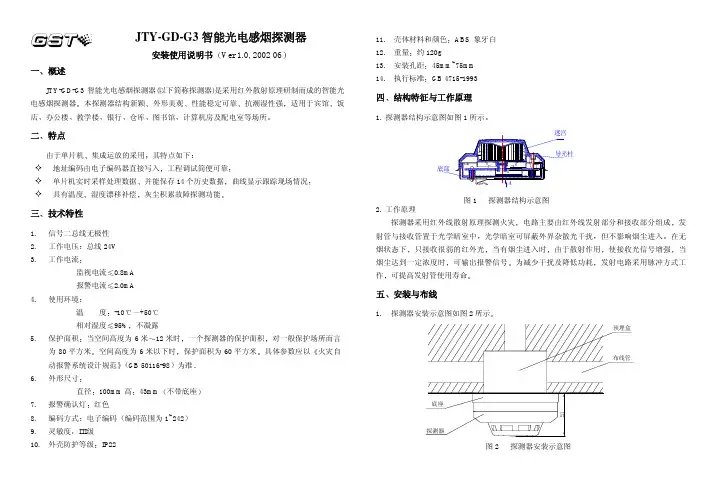

JTY-GD-JBF5100点型光电感烟火灾探测器使用说明书(使用产品前,请阅读使用说明书)1概述1.1 产品特点⚫内置消防行业专用朱鹮微处理器,探测器对自身采集到的数据进行存储和判断,具有自诊断功能;⚫污染自动补偿。
根据自身的污染程度进行零位漂移,最大程度减少误报;⚫适用范围广,对不同材质燃烧后产生的白烟或黑烟均可响应;⚫抗干扰、抗潮湿能力强;⚫二总线,无极性。
功耗低,最远传输距离1000m。
1.2 适用范围⚫点型光电感烟火灾探测器是对火灾早期阶段和阴燃阶段所产生的烟雾粒子作出有效的响应。
主要用来探测可见或不可见的燃烧产物及起火速度缓慢的初期火灾,适用于宾馆客房、办公楼、图书馆、影剧院邮政大楼等公共场所,或用于其它不宜安装感温探测器的厅堂和公共场所。
⚫满足国家标准:GB 4715-2005《点型感烟火灾探测器》。
1.3 型号组成JTY-GD-JBF 5100产品代号公司代号国家标准规定的分类代号2 工作原理点型光电感烟火灾探测器由迷宫,红外发射部分,红外接收部分及相应的放大处理等电路组成。
正常工作时,当迷宫中没有烟时,红外发射管发出的红外光不能到达接收管,因此,放大器没有输出;而当迷宫中有烟时,红外发光管发出的光由于烟的散色作用,有部分红外光到达接收管,迷宫中烟的浓度越大,放大器输出就越大,当烟浓度达到设定报警阈值时电路给出报警信号。
3 性能参数环境特性工作温度-10~+55℃贮存温度-20~+65℃相对湿度≤95%(无凝露)防爆特性防爆标志不涉及电气特性工作电压DC24V(DC19V~DC27V)调制型,控制器提供监视电流≤ 0.3mA(DC24V)报警电流≤ 1mA(DC24V)确认灯监视状态瞬时微亮,报警常亮(红色)通讯特性线制二线制(无极性)编址范围1~200编址方式电子编码器最远传输距离1000m兼容性JBF-11SF、JBF50XX等系列控制器机械特性外观PANTONE Warm Gray 1 C 米白色外壳材质ABS产品质量92.5g外形尺寸Φ100mm ×H 46mm(含底座)探测特性保护面积保护面积60-80m²认证特性消防认证执行标准GB 4715-2005《点型感烟火灾探测器》4 安装调试4.1 安装说明/步骤⚫外形及安装尺寸如图1所示:图1 外形及安装尺寸图⚫将探测器底座用2只M4的螺钉紧固在预埋盒上;⚫采用截面积1.0mm²以上的双绞导线,将回路两总线L1、L2 分别接在端子L1 和端子L2 上,接线不分极性;⚫用编码器对探测器写入部位号(1-200);⚫将探测器嵌入底座,然后按顺时针方向拧紧即可;⚫安装时宜带手套操作,以保持探测器外壳清洁;⚫安装图例:预埋盒底座探测器导光柱图2 安装图例⚫接线图例:L1L2火灾报警控制器图3 接线图例4.2 调试方法⚫验收依据:《火灾自动报警系统施工及验收规范》5 故障分析与排除6 保养、维护⚫ 日常维护、保养、校准:建议检测验收前加防尘罩保护,但系统正式运行前一定要去掉防尘罩。
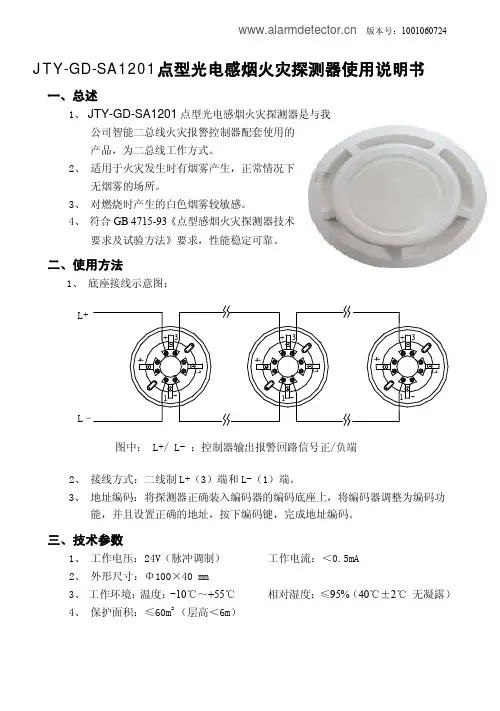
版本号:1001060724点型光电感烟火灾探测器使用说明书一、总述1、点型光电感烟火灾探测器是与我公司智能二总线火灾报警控制器配套使用的产品,为二总线工作方式。
2、 适用于火灾发生时有烟雾产生,正常情况下无烟雾的场所。
3、 对燃烧时产生的白色烟雾较敏感。
4、 符合GB 4715-93《点型感烟火灾探测器技术要求及试验方法》要求,性能稳定可靠。
二、使用方法1、 底座接线示意图:图中: L+/ L- :控制器输出报警回路信号正/负端2、 接线方式:二线制L+(3)端和L-(1)端。
3、 地址编码:将探测器正确装入编码器的编码底座上,将编码器调整为编码功能,并且设置正确的地址,按下编码键,完成地址编码。
三、技术参数1、 工作电压:24V (脉冲调制) 工作电流:<0.5mA2、 外形尺寸:Φ100×40 mm3、 工作环境:温度:-10℃~+55℃ 相对湿度:≤95%(40℃±2℃ 无凝露)4、 保护面积:≤60m 2 (层高<6m )L 版本号:1001060724四、注意事项1、本探测器不适用于燃烧时完全产生黑烟的场所,以及燃烧时无烟或极少产生烟的场所。
2、探测器地址设定且确认与控制器连接无误后接通电源,当在控制器中登录此探测器地址后,该探测器的红色指示灯将闪烁。
3、当探测器处于火警状态下时,红色指示灯常亮。
只有在系统复位或短暂掉电且又重新上电后,探测器上红色指示灯才由常亮恢复闪烁状态。
4、同一报警回路,属于同类地址空间的产品不允许具有相同的地址,否则系统可能无法正常工作。
5、随探测器附带的防尘罩,在现场安装结束未开通使用前,请勿过早摘除,以免探测器受到污染。
6、探测器离空调出风口的安装距离至少1.5米。
7、安装应符合GB 50116-92《火灾自动报警系统施工及验收规范》中的规定。
五、维护和检测1、从产品出厂之日起一年内,按规定要求正常使用的探测器,如因材料或制造工艺的缺陷而失效,深圳市泛海三江电子有限公司将负责免费维修或更换。
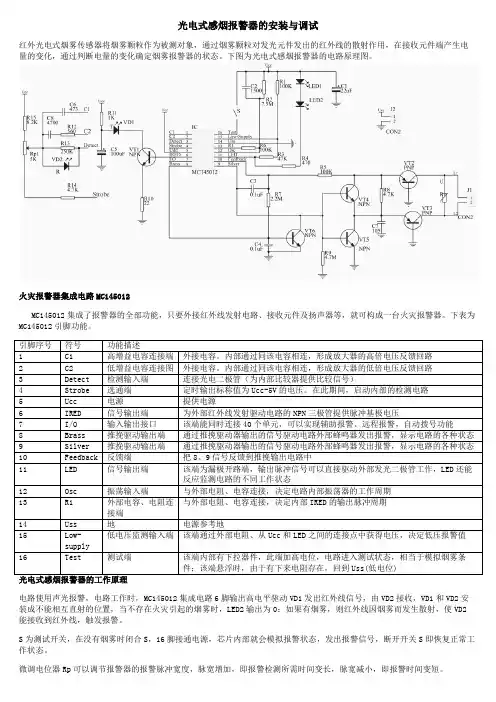
光电式感烟报警器的安装与调试红外光电式烟雾传感器将烟雾颗粒作为被测对象,通过烟雾颗粒对发光元件发出的红外线的散射作用,在接收元件端产生电量的变化,通过判断电量的变化确定烟雾报警器的状态。
下图为光电式感烟报警器的电路原理图。
火灾报警器集成电路MC145012MC145012集成了报警器的全部功能,只要外接红外线发射电路、接收元件及扬声器等,就可构成一台火灾报警器。
下表为MC145012引脚功能。
电路使用声光报警,电路工作时,MC145012集成电路6脚输出高电平驱动VD1发出红外线信号,由VD2接收,VD1和VD2安装成不能相互直射的位置,当不存在火灾引起的烟雾时,LED2输出为0;如果有烟雾,则红外线因烟雾而发生散射,使VD2能接收到红外线,触发报警。
S为测试开关,在没有烟雾时闭合S,16脚接通电源,芯片内部就会模拟报警状态,发出报警信号,断开开关S即恢复正常工作状态。
微调电位器Rp可以调节报警器的报警脉冲宽度,脉宽增加,即报警检测所需时间变长,脉宽减小,即报警时间变短。
C6 C8 R12组成增益调节电路,可以调节系统的放大倍数,也可以作为一种调节灵敏度的方法。
在有烟雾时,由于烟雾颗粒造成的光电二极管的变化很小,因此内置放大电路,调整C6 C8 R12的参数,即可调整放大器的增益倍数,达到调节灵敏度的效果。
其中C6作为粗调元件单独使用,C8作为增益的微调元件,需要与R12配合使用。
时钟电路为RC电路,由R2 R6 C2组成,向12脚提供周期性的脉冲信号。
电源低压报警电路是在系统电源电压过低时发出报警信号,提示及时更换电池,R1 R3串联在电源电压和11脚之间,向15脚提供电源最低允许电压。
当电源电压小于最低允许电压时,9脚输出一个高电平,推动复合三极管输出,提示报警,调节R1与R2比值大小,可以改变电源最低允许电压值。
元件清单。
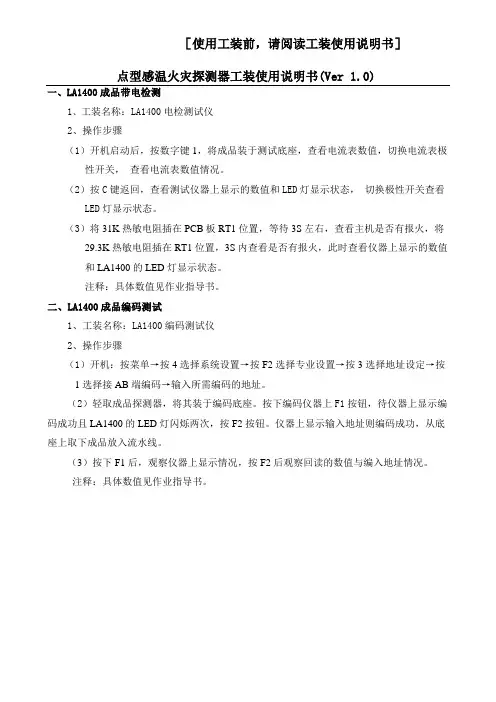
[使用工装前,请阅读工装使用说明书]
点型感温火灾探测器工装使用说明书(Ver 1.0)
一、LA1400成品带电检测
1、工装名称:LA1400电检测试仪
2、操作步骤
(1)开机启动后,按数字键1,将成品装于测试底座,查看电流表数值,切换电流表极性开关,查看电流表数值情况。
(2)按C键返回,查看测试仪器上显示的数值和LED灯显示状态,切换极性开关查看LED灯显示状态。
(3)将31K热敏电阻插在PCB板RT1位置,等待3S左右,查看主机是否有报火,将
29.3K热敏电阻插在RT1位置,3S内查看是否有报火,此时查看仪器上显示的数值
和LA1400的LED灯显示状态。
注释:具体数值见作业指导书。
二、LA1400成品编码测试
1、工装名称:LA1400编码测试仪
2、操作步骤
(1)开机:按菜单→按4选择系统设置→按F2选择专业设置→按3选择地址设定→按1选择接AB端编码→输入所需编码的地址。
(2)轻取成品探测器,将其装于编码底座。
按下编码仪器上F1按钮,待仪器上显示编码成功且LA1400的LED灯闪烁两次,按F2按钮。
仪器上显示输入地址则编码成功,从底座上取下成品放入流水线。
(3)按下F1后,观察仪器上显示情况,按F2后观察回读的数值与编入地址情况。
注释:具体数值见作业指导书。
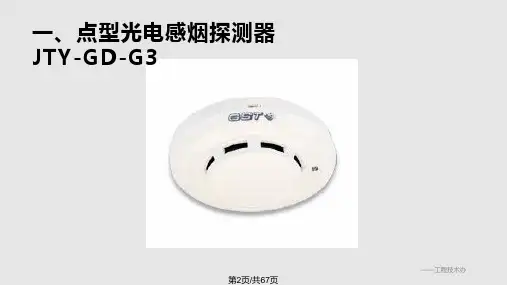
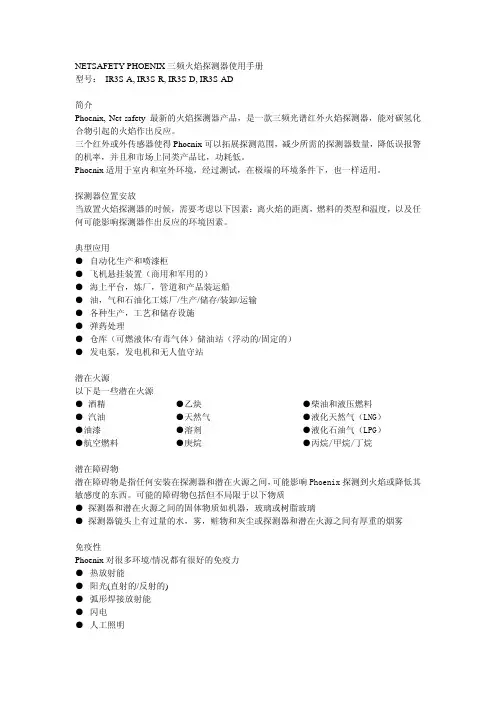
JTY-GD-G3点型光电感烟火灾探测器安装使用说明书一、概括JTY-GD-G3点型光电感烟火灾探测器 (以下简称探测器 )是采纳红外散射原理研制而成的点型光电感烟火灾探测器。
本探测器构造新奇、外形雅观、性能稳固靠谱、抗湿润性强,合用于旅馆、饭店、办公楼、教课楼、银行、库房、图书室、计算机房、配电室及船舶等场所。
二、特色1.地点编码可由电子编码器预先写入,也可由控制器直接改正,工程调试简易靠谱。
2.单片机及时采样办理数据、并能保留14 个历史数据,曲线显示追踪现场状况。
3.拥有温度、湿度漂移赔偿,尘埃累积程度及故障探测功能。
4.无极性二总线信号。
三、技术特征1.工作电压:信号总线电压:总线24V同意范围:16V~28V2.工作电流:监督电流≤报警电流≤3.指示灯:报警确认灯,红色,巡检时闪耀,报警常常亮4.编码方式:电子编码(编码范围为1~ 242)5. 保护面积:当空间高度为 6 m~ 12 m 时,一个探测器的保护面积,对一般保护场所而言为80 m 2。
空间高度为 6 m 以下时,保护面积为 60 m2。
详细参数应以《火灾自动报警系统设计规范》( GB 50116)为准。
6.线制:信号二总线无极性7.使用环境:温度: -10℃~ +55℃相对湿度≤ 95%,不凝露8. 外形尺寸:直径100mm高56mm(带底座)9.外壳防备等级: IP2310.壳体资料和颜色: ABS,象牙白11.重量:约 120g12.安装孔距: 45mm ~75mm13.履行标准: GB 4715-2005四、构造特色与工作原理1.探测器外形表示图如图 1 所示。
2.工作原理探测器采纳红外线散射原理探测火灾,在无烟状态下,只接收很弱的红外光,当有烟尘进入时,因为散射作用,使接收光信号加强,当烟尘达到必定浓度时,可输出报警信号。
为减少扰乱及降低功耗,发射电路采纳脉冲方式工作,可提升发射管使用寿命。
42tinaP t o N oD6 00 0 0 0 H图 1 探测器外形表示图五、 安装与布线警示:安装探测器从前,请切断回路的电源并确认所有底座已安装牢靠。
版本号:18JTY-GD-930 型点型光电感烟火灾探测器使用说明书五、产品使用与工程应用1. 配套安装底座示意图,如图2 所示:- - - - - - 安装、使用产品前,请详细阅读产品使用说明书- - - - -一、产品概述JTY-GD-930 型点型光电感烟火灾探测器(以下简称探测器)是一种光电型感烟火灾探测器。
探测器内置微处理器,支持电编码,通过二线制总线接入相兼容的9000 系列火灾报警控制器。
探测器既能实时采集现场烟雾浓度数据,并将数据传送至火灾报警控制器,也能接收并执行火灾报警控制器给出的控制命令。
端子定义(无极性两线制):1 -- 信号端(L1)2 -- 空脚探测器适用于火灾发生时有大量烟雾产生,而正常情况下无烟雾的场所,例:3 -- 信号端(L2)饭店、旅馆、教学楼、办公楼、计算机房、通讯机房、书库和档案库等工业与民4 -- 空脚用建筑。
但不适用于有大量粉尘、水雾滞留的场所,可能产生蒸汽和油雾的场所及正常情况下有烟滞留的场所。
图2二、产品特点✓全电子编码,可通过编码器现场改写。
✓单片机实时采样处理数据、并能保存最近144 条历史数据,曲线跟踪现场情况。
2. 接线方式:探测器通过二线制总线接入相兼容的火灾报警控制器,采用无极性连接,二线制总线的L1、L2 与配套底座的1 端和3 端相连。
多个探测器与控制器相连接的示意图如图3 所示。
✓具有温度、湿度、灰尘积累漂移补偿,传感器失效检测功能(故障上报控制器)。
✓无极性二总线连接,安装、维护方便。
✓采用上、下盖结构设计,独立底座安装,安装、调试、维护简单方便。
三、产品技术参数1. 执行标准:GB4715-2005 智能二总线控制器2. 工作电压:24V(脉冲调制)3. 工作电流:监视状态<300uA,报警状态<1.5mA4. 工作指示:监视状态红色指示灯闪烁,报警状态红色指示灯常亮5. 重量:约70g 图36. 外形尺寸:直径100mm,高55mm(带底座)7. 接线方式:无极性二总线制(L1、L2)3. 地址编码:如图4 所示,将探测器通过编码器上探测器底座接入,L1、L2 采用无极性连接,8. 使用环境:室内,温度-10℃~+55℃,相对湿度≤95%(40℃±2℃无凝露)把编码器设定为编码功能,编制正确的地址码,按下“运行”键,完成地址编码设置。
海湾配套说明点型火灾探测器报警功能检验要求点型火灾探测器报警功能检验要求:1)点型感烟火灾探测器应在试验烟气的作用下动作,向火灾报警控制器输出火警信号。
2)点型感温火灾探测器应在试验热源的作用下动作,向火灾报警控制器输出火警信号。
类别:1)、2)A类检验器具:火灾探测器试验装置海湾消防设备线制说明海湾报警系统中,布线说明(海湾消防设备线制说明):信号二总线:采用RVS线截面积≥1.0mm²线RS-485通讯二总线:采用RVSP屏蔽双绞线截面积≥1.0mm ²线多线制控制线:采用BV线截面积≥1.5mm²线,3根线为启动、公共、反馈DC24V电源二总线:竖井采用BV线截面积≥4.0mm ²线;平面采用BV线截面积≥2.5mm ²线消防广播二总线:采用BV线截面积≥1.5mm ²线消防电话二总线:采用RVVP屏蔽线截面积≥1.0mm²线海湾手动报警按钮防雨罩和立柱使用说明海湾常用防爆场合的手动报警按钮型号有J-SAF-GST9211(Ex)和J-SAM-GST9116。
海湾防爆手动按钮在室外安装时可采用立柱和壁挂安装两种形式,本文将介绍两种海湾防爆手报按钮室外安装配套型号及示意图。
1、J-SAF-GST9211(Ex)手动报警按钮室外立柱安装配套产品:LZ10001型防雨罩与LZ1000型立柱;壁挂安装时配套产品:LZ10002型防雨罩。
LZ10001型防雨罩与LZ1000型立柱配套安装示意图如图所示LZ10002型防雨罩采用壁挂式安装,防护等级IP65,其外型尺寸及安装示意图如图所示2、J-SAM-GST9116手动报警按钮室外立柱安装配套产品:LZ10011型防雨罩与LZ1001型立柱;壁挂安装时配套产品:LZ10011型防雨罩。
LZ10011型防雨罩与LZ1001型立柱配套安装示意图如图所示壁挂安装方式示意图如图所示海湾电话插孔8312接线末端接4.7kΩ终端电阻海湾GST-LD-8312消防电话插孔端子XT1电话线输入端,端子XT2电话线输出端,接下一个电话插孔,最末端电话插孔XT2接线端子接4.7kΩ终端电阻。
安装、使用产品前,请阅读安装使用说明书
JTY-GD-G3点型光电感烟火灾探测器
安装使用说明书
一、概述
JTY-GD-G3点型光电感烟火灾探测器(以下简称探测器)是采用红外散射原理研制而成的点型光电感烟火灾探测器。
本探测器结构新颖、外形美观、性能稳定可靠、抗潮湿性强,适用于宾馆、饭店、办公楼、教学楼、银行、仓库、图书馆、计算机房、配电室及船舶等场所。
二、特点
1.地址编码可由电子编码器事先写入,也可由控制器直接更改,工程调试简便可靠。
2.单片机实时采样处理数据、并能保存14个历史数据,曲线显示跟踪现场情况。
3.具有温度、湿度漂移补偿,灰尘积累程度及故障探测功能。
4.无极性二总线信号。
三、技术特性
1.工作电压:
信号总线电压:总线24V 允许范围:16V~28V
2.工作电流:
监视电流≤0.6mA
报警电流≤1.8mA
3.指示灯:报警确认灯,红色,巡检时闪烁,报警时常亮
4.编码方式:电子编码(编码范围为1~242)
5.保护面积:当空间高度为6 m~12 m时,一个探测器的保护面积,对一般保护场所而言为80 m2。
空间高度为6 m以下时,保护面积为60 m2。
具体参数应以《火灾自动报警系统设计规范》(GB 50116)为准。
6.线制:信号二总线无极性
7.使用环境:
温度:-10℃~+55℃
相对湿度≤95%,不凝露
8.外形尺寸:直径100mm 高56mm(带底座)
9.外壳防护等级:IP23
10.壳体材料和颜色:ABS,象牙白
11.重量:约120g
12.安装孔距:45mm~75mm
13.执行标准:GB 4715-2005
四、结构特征与工作原理
1.探测器外形示意图如图1所示。
2.工作原理
探测器采用红外线散射原理探测火灾,在无烟状态下,只接收很弱的红外光,当有烟尘进入时,由于散射作用,使接收光信号增强,当烟尘达到一定浓度时,可输出报警信号。
为减少干扰及降低功耗,发射电路采用脉冲方式工作,可提高发射管使用寿命。
待底座安装牢固后,将探测器底部对正底座顺时针旋转,即可将探测器安装在底座上。
1.探测器安装结束后或每次定期维护保养后必须进行测试。
2.测试内容:
注册:确认安装与布线正确之后,通过连接的控制器进行在线设备注册,核对已安装的探测器数量与控制器注册到的探测器数量是否一致。
模拟火警:注册测试后,任选一探测器,人为使它满足火警条件,验证探测器是否正常报火警。
3.测试结束后,通过控制器发出通讯命令使探测器复位,并通知有关管理部门系统恢复正常。
4.在测试过程中不合格的探测器按“常见故障及维修”及“维护保养”进行处理,然后再进行测试,如仍不能通过测试,则应返厂维修。
注意:首次测试时应取下防尘罩,正常运行前应安装防尘罩,防止灰尘进入。
七、使用及操作
本探测器的编码方式为电子编码,该编码方式简便快捷,现场编码时可利用本公司生产的GST-BMQ-1B型或GST-BMQ-2型电子编码器进行,编码时将电子编码器与探测器的总线端子接好,即可以进行地址码的写入和读出。
1.地址码的写入
a)打开电子编码器电源。
b)输入地址码(1—242),按下“编码”键,屏幕上将显示一个“P”,表明相应的地址码已被
写入,按下“清除”键返回。
c)若编码失败,则显示错误信息“E”,按下“清除”键,显示“0”,可重新进行操作。
2.地址码读出
a)打开电子编码器电源,按下“读码”键,屏幕上将显示设备的地址码。
b)若读码失败,屏幕上将显示错误信息“E”,按“清除”键清除,可重新进行操作。
八、常见故障及维修
发生故障时,首先应检查外部接线是否正确,紧固螺丝是否松动,若正常,再打开外壳,观察线路板是否有虚焊、烧焦等异常现象。
探测器在使用过程中,可能出现的故障现象及维修办法归纳如下:
1.报通信故障或点名不正常。
a)检查VD1、VD2、VD3、VD4是否开路,PN节电压是否正常。
b)检查D2是否有+5V输出。
c)检查三极管VT1、VT2的e、b、c引脚间PN结电压是否正常。
2.总线短路故障。
a)检查二极管VD1、VD2、VD3、VD4是否击穿对地短路。
b)贴片电阻R1、R2是否短路。
c)总线端子是否与地短接。
3.误报火警:检查迷宫是否过脏。
九、维护保养
1.探测器应在即将调试前方可安装,在安装前应妥善保管;并应采取相应的防尘、防潮、防腐蚀措施。
2.探测器应注意防尘,防尘罩必须在工程正式投入使用后方可摘下。
3.探测器每年至少清洁一次,以保证系统的正常运行。
4.工程上如发现探测器有经常性误报的现象,则应对迷宫进行清洗,必要时,可更换迷宫。
清洗迷宫步骤:
a)首先用手捏住迷宫体两侧轻轻摇动将其拔下。
b)用镊子夹住酒精棉球仔细清洗迷宫体内腔,注意不要将棉絮留入迷宫体内。
c)安装好迷宫体。
5.探测器在进行清洁之前,应通知有关管理部门,系统将进行维护,会因此而临时停止工作。
同时应切断将进行维护的区域或系统的逻辑控制功能,以免造成不必要的报警联动。
6.探测器清洁后,将探测器重新安装好,然后进行测试。
7.每半年应进行一次模拟火警试验,测试探测器是否工作正常。
十、注意事项
1.防尘罩必须在工程正式投入使用后方可摘下,请妥善保管防尘罩以备后用。
2.防尘罩可以有效地限制灰尘进入探测器,然而却不可能彻底杜绝空气中的浮尘微粒进入探测器内。
因此,建议在进行土建施工、装修或其它会产生灰尘的活动开始以前卸下探测器,但必须通知有关管理部门。
3.在进行维护保养时,应小心以避免损坏探测器。
4.在探测器周围0.5m内,不应有遮挡物。
5.探测器至空调送风孔边的水平距离不应小于1.5m。
6.探测器至墙壁、梁边的水平距离不应小于0.5m。
7.探测器宜水平安装,如必须倾斜安装时,倾斜角不应大于45°。
8.探测器底座应安装牢固,其导线连接必须可靠。
9.探测器的报警确认灯,应面向便于人员观察的主要入口方向。